
Concept explainers
(a)
Interpretation:
Structural formula for the given name has to be drawn.
Concept Introduction:
Nomenclature of Ether compounds:
The naming of theorganic compound is given by IUPAC (International Union for pure and applied chemistry). In the IUPAC names consist of certain rules for giving chemical names they are,
Ethers are named by selecting the longest carbon chain as the parent
Common name: List the alkyl groups bonded to Oxygen in alphabetical order and adding the word ‘ether’.
Cyclic ether: The presence of Oxygen atom in a saturated ring is indicated by the prefix ox-, and ring sizes from three to six are indicated by the endings –irane, etane, olane, and –ane, respectively.
Numbering of the atoms of the ring begins with the oxygen atom. These compounds and others in which there is a heteroatom (non-carbon atom) in the ring are called heterocycles.
(a)
Explanation of Solution
IUPAC name: 2-(1-Methylethoxy)propane
Ethers are named by selecting the longest carbon chain as the parent alkane and naming the –OR group bonded to it an alkoxy group.
Using the above principle, the longest carbon chain is propane (contains three carbons) as the parent alkane; naming the –OR group as alkoxy that is ‘2-(1-methylethoxy).
Therefore, the structure obtained is,
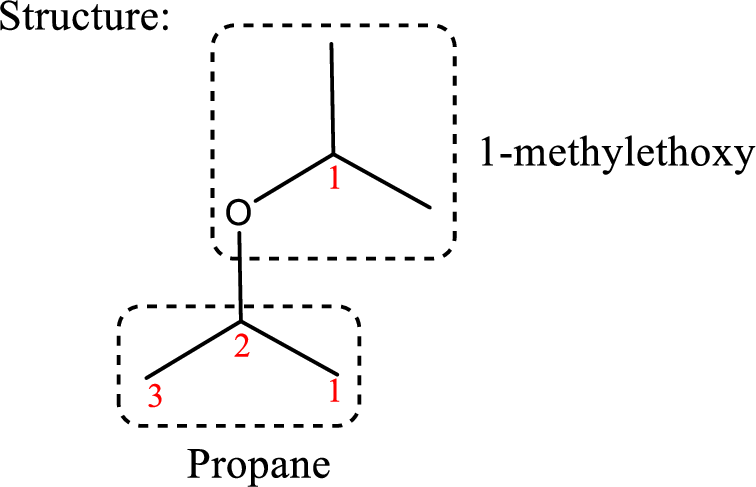
(b)
Interpretation:
Structural formula for the given name has to be drawn.
Concept Introduction:
Nomenclature of Ether compounds:
The naming of theorganic compound is given by IUPAC (International Union for pure and applied chemistry). In the IUPAC names consist of certain rules for giving chemical names they are,
Ethers are named by selecting the longest carbon chain as the parent alkane and naming the –OR group bonded to it an alkoxy group.
Common name: List the alkyl groups bonded to Oxygen in alphabetical order and adding the word ‘ether’.
Cyclic ether: The presence of Oxygen atom in a saturated ring is indicated by the prefix ox-, and ring sizes from three to six are indicated by the endings –irane, etane, olane, and –ane, respectively.
Numbering of the atoms of the ring begins with the oxygen atom. These compounds and others in which there is a heteroatom (non-carbon atom) in the ring are called heterocycles.
(b)
Explanation of Solution
IUPAC name: trans-2,3-Diethyloxirane
Cyclic ether: The presence of Oxygen atom in a saturated ring is indicated by the prefix ox-, and ring sizes from three to six are indicated by the endings –irane, etane, olane, and –ane, respectively.
Numbering of the atoms of the ring begins with the oxygen atom. These compounds and others in which there is a heteroatom (non-carbon atom) in the ring are called heterocycles.
Using the above principle, the name‘oxirane’ contains two carbons along with one Oxygen atom in a cyclic ringalong with two ‘ethyl’ substituentsin the ring.
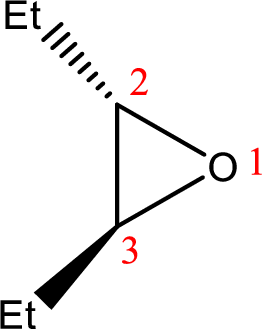
(c)
Interpretation:
Structural formula for the given name has to be drawn.
Concept Introduction:
Nomenclature of Ether compounds:
The naming of theorganic compound is given by IUPAC (International Union for pure and applied chemistry). In the IUPAC names consist of certain rules for giving chemical names they are,
Ethers are named by selecting the longest carbon chain as the parent alkane and naming the –OR group bonded to it an alkoxy group.
Common name: List the alkyl groups bonded to Oxygen in alphabetical order and adding the word ‘ether’.
Cyclic ether: The presence of Oxygen atom in a saturated ring is indicated by the prefix ox-, and ring sizes from three to six are indicated by the endings –irane, etane, olane, and –ane, respectively.
Numbering of the atoms of the ring begins with the oxygen atom. These compounds and others in which there is a heteroatom (non-carbon atom) in the ring are called heterocycles.
(c)
Explanation of Solution
IUPAC name:trans-2-Ethoxycyclopentanol
Ethers are named by selecting the longest carbon chain as the parent alkane and naming the –OR group bonded to it an alkoxy group.
Here, the –OH group is preferred as the first priority and the compound is ‘alcohol’.
In the given compound, the longest carbon chain contains five carbons in a cyclic ring; the parent name is CYCLOPETANE and numbering the parent chain begins with carbon attached to the –OH group located at C-1 and the substituent ‘ethoxy’ is located at C-2.
Therefore, the structure is,
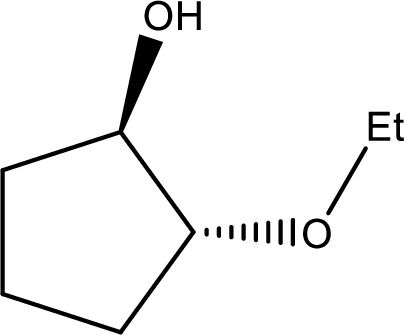
(d)
Interpretation:
Structural formula for the given name has to be drawn.
Concept Introduction:
Nomenclature of Ether compounds:
The naming of theorganic compound is given by IUPAC (International Union for pure and applied chemistry). In the IUPAC names consist of certain rules for giving chemical names they are,
Ethers are named by selecting the longest carbon chain as the parent alkane and naming the –OR group bonded to it an alkoxy group.
Common name: List the alkyl groups bonded to Oxygen in alphabetical order and adding the word ‘ether’.
Cyclic ether: The presence of Oxygen atom in a saturated ring is indicated by the prefix ox-, and ring sizes from three to six are indicated by the endings –irane, etane, olane, and –ane, respectively.
Numbering of the atoms of the ring begins with the oxygen atom. These compounds and others in which there is a heteroatom (non-carbon atom) in the ring are called heterocycles.
(d)
Explanation of Solution
IUPAC name:Ethenyloxyethene.
Ethers are named by selecting the longest carbon chain as the parent alkane and naming the –OR group bonded to it an alkoxy group.
Using the above principle, the longest carbon chain isethene (contains two carbons with a double bond) as the parent
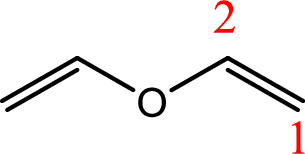
(e)
Interpretation:
Structural formula for the given name has to be drawn.
Concept Introduction:
Nomenclature of Ether compounds:
The naming of theorganic compound is given by IUPAC (International Union for pure and applied chemistry). In the IUPAC names consist of certain rules for giving chemical names they are,
Ethers are named by selecting the longest carbon chain as the parent alkane and naming the –OR group bonded to it an alkoxy group.
Common name: List the alkyl groups bonded to Oxygen in alphabetical order and adding the word ‘ether’.
Cyclic ether: The presence of Oxygen atom in a saturated ring is indicated by the prefix ox-, and ring sizes from three to six are indicated by the endings –irane, etane, olane, and –ane, respectively.
Numbering of the atoms of the ring begins with the oxygen atom. These compounds and others in which there is a heteroatom (non-carbon atom) in the ring are called heterocycles.
(e)
Explanation of Solution
IUPAC name:Cyclohexene oxide:
Cyclic ether: The presence of Oxygen atom in a saturated ring is indicated by the prefix ox-, and ring sizes from three to six are indicated by the endings –irane, etane, olane, and –ane, respectively.
Numbering of the atoms of the ring begins with the oxygen atom. These compounds and others in which there is a heteroatom (non-carbon atom) in the ring are called heterocycles.
Using the above principle, the longest carbon cyclic ring contains sixcarbon atoms andone Oxygen atom is located at C-1 and 2 as three membered ring.
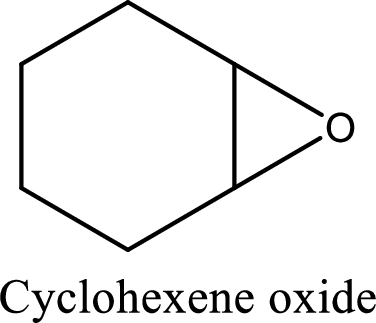
(f)
Interpretation:
Structural formula for the given name has to be drawn.
Concept Introduction:
Nomenclature of Ether compounds:
The naming of theorganic compound is given by IUPAC (International Union for pure and applied chemistry). In the IUPAC names consist of certain rules for giving chemical names they are,
Ethers are named by selecting the longest carbon chain as the parent alkane and naming the –OR group bonded to it an alkoxy group.
Common name: List the alkyl groups bonded to Oxygen in alphabetical order and adding the word ‘ether’.
Cyclic ether: The presence of Oxygen atom in a saturated ring is indicated by the prefix ox-, and ring sizes from three to six are indicated by the endings –irane, etane, olane, and –ane, respectively.
Numbering of the atoms of the ring begins with the oxygen atom. These compounds and others in which there is a heteroatom (non-carbon atom) in the ring are called heterocycles.
(f)
Explanation of Solution
IUPAC name:3-Cyclopropyloxy-1-propene
Ethers are named by selecting the longest carbon chain as the parent alkane and naming the –OR group bonded to it an alkoxy group.
Using the above principle, the longest carbon chain ispropene (contains three carbons with a double bond) as the parent alkene; naming the–OR groups as alkoxy that is 3-Cyclopropyloxy.
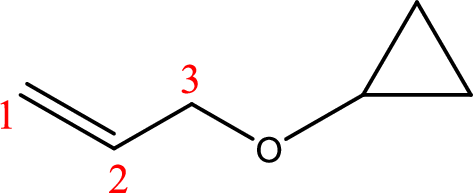
(g)
Interpretation:
Structural formula for the given name has to be drawn.
Concept Introduction:
Nomenclature of Ether compounds:
The naming of theorganic compound is given by IUPAC (International Union for pure and applied chemistry). In the IUPAC names consist of certain rules for giving chemical names they are,
Ethers are named by selecting the longest carbon chain as the parent alkane and naming the –OR group bonded to it an alkoxy group.
Common name: List the alkyl groups bonded to Oxygen in alphabetical order and adding the word ‘ether’.
Cyclic ether: The presence of Oxygen atom in a saturated ring is indicated by the prefix ox-, and ring sizes from three to six are indicated by the endings –irane, etane, olane, and –ane, respectively.
Numbering of the atoms of the ring begins with the oxygen atom. These compounds and others in which there is a heteroatom (non-carbon atom) in the ring are called heterocycles.
(g)
Explanation of Solution
IUPAC name:(R)-2-Methyloxirane
Cyclic ether: The presence of Oxygen atom in a saturated ring is indicated by the prefix ox-, and ring sizes from three to six are indicated by the endings –irane, etane, olane, and –ane, respectively.
Numbering of the atoms of the ring begins with the oxygen atom. These compounds and others in which there is a heteroatom (non-carbon atom) in the ring are called heterocycles.
Using the above principle, the longest three membered cyclic ringscontaintwo carbon atoms and one Oxygen atom and the substituent methyl group is located at C-2.
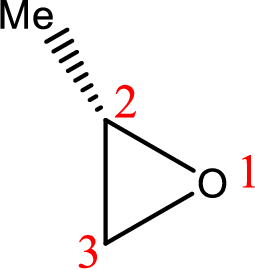
(h)
Interpretation:
Structural formula for the given name has to be drawn.
Concept Introduction:
Nomenclature of Ether compounds:
The naming of theorganic compound is given by IUPAC (International Union for pure and applied chemistry). In the IUPAC names consist of certain rules for giving chemical names they are,
Ethers are named by selecting the longest carbon chain as the parent alkane and naming the –OR group bonded to it an alkoxy group.
Common name: List the alkyl groups bonded to Oxygen in alphabetical order and adding the word ‘ether’.
Cyclic ether: The presence of Oxygen atom in a saturated ring is indicated by the prefix ox-, and ring sizes from three to six are indicated by the endings –irane, etane, olane, and –ane, respectively.
Numbering of the atoms of the ring begins with the oxygen atom. These compounds and others in which there is a heteroatom (non-carbon atom) in the ring are called heterocycles.
(h)
Explanation of Solution
IUPAC name:1,1-Dimethyloxycyclohexane,
Ethers are named by selecting the longest carbon chain as the parent alkane and naming the –OR group bonded to it an alkoxy group.
Using the above principle, the longest carbon ringiscyclohexane (contains six carbons) as the parent alkane; naming the two–OR groups as alkoxy that bothmethoxy groups located at C-1.
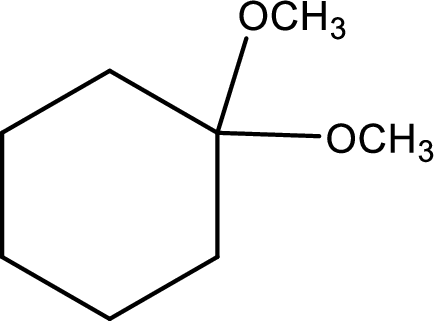
Want to see more full solutions like this?
Chapter 11 Solutions
OWL V2 with MindTap Reader and Student Solutions Manual eBook for Brown/Iverson/Anslyn/Foote's Organic Chemistry, 8th Edition
- For each reaction below, decide if the first stable organic product that forms in solution will create a new CC bond, and check the appropriate box. Next, for each reaction to which you answered "Yes" to in the table, draw this product in the drawing area below. Note for advanced students: for this problem, don't worry if you think this product will continue to react under the current conditions - just focus on the first stable product you expect to form in solution. དྲ。 ✗MgBr ? O CI Will the first product that forms in this reaction create a new C-C bond? Yes No • ? Will the first product that forms in this reaction create a new CC bond? Yes No × : ☐ Xarrow_forwardPredict the major products of this organic reaction: OH NaBH4 H ? CH3OH Note: be sure you use dash and wedge bonds when necessary, for example to distinguish between major products with different stereochemistry. Click and drag to start drawing a structure. ☐ : Sarrow_forwardPredict the major products of this organic reaction: 1. LIAIHA 2. H₂O ? Note: be sure you use dash and wedge bonds when necessary, for example to distinguish between major products with different stereochemistry. Click and drag to start drawing a structure. X : ☐arrow_forward
- For each reaction below, decide if the first stable organic product that forms in solution will create a new C - C bond, and check the appropriate box. Next, for each reaction to which you answered "Yes" to in the table, draw this product in the drawing area below. Note for advanced students: for this problem, don't worry if you think this product will continue to react under the current conditions - just focus on the first stable product you expect to form in solution. NH2 tu ? ? OH Will the first product that forms in this reaction create a new CC bond? Yes No Will the first product that forms in this reaction create a new CC bond? Yes No C $ ©arrow_forwardAs the lead product manager at OrganometALEKS Industries, you are trying to decide if the following reaction will make a molecule with a new C-C bond as its major product: 1. MgCl ? 2. H₂O* If this reaction will work, draw the major organic product or products you would expect in the drawing area below. If there's more than one major product, you can draw them in any arrangement you like. Be sure you use wedge and dash bonds if necessary, for example to distinguish between major products with different stereochemistry. If the major products of this reaction won't have a new CC bond, just check the box under the drawing area and leave it blank. Click and drag to start drawing a structure. This reaction will not make a product with a new CC bond. G marrow_forwardIncluding activity coefficients, find [Hg22+] in saturated Hg2Br2 in 0.00100 M NH4 Ksp Hg2Br2 = 5.6×10-23.arrow_forward
- give example for the following(by equation) a. Converting a water insoluble compound to a soluble one. b. Diazotization reaction form diazonium salt c. coupling reaction of a diazonium salt d. indacator properties of MO e. Diazotization ( diazonium salt of bromobenzene)arrow_forward2-Propanone and ethyllithium are mixed and subsequently acid hydrolyzed. Draw and name the structures of the products.arrow_forward(Methanesulfinyl)methane is reacted with NaH, and then with acetophenone. Draw and name the structures of the products.arrow_forward
- 3-Oxo-butanenitrile and (E)-2-butenal are mixed with sodium ethoxide in ethanol. Draw and name the structures of the products.arrow_forwardWhat is the reason of the following(use equations if possible) a.) In MO preperation through diazotization: Addition of sodium nitrite in acidfied solution in order to form diazonium salt b.) in MO experiment: addition of sodium hydroxide solution in the last step to isolate the product MO. What is the color of MO at low pH c.) In MO experiment: addition of sodium hydroxide solution in the last step to isolate the product MO. What is the color of MO at pH 4.5 d.) Avoiding not cooling down the reaction mixture when preparing the diazonium salt e.) Cbvcarrow_forwardA 0.552-g sample of an unknown acid was dissolved in water to a total volume of 20.0 mL. This sample was titrated with 0.1103 M KOH. The equivalence point occurred at 29.42 mL base added. The pH of the solution at 10.0 mL base added was 3.72. Determine the molar mass of the acid. Determine the Ka of the acid.arrow_forward
 ChemistryChemistryISBN:9781305957404Author:Steven S. Zumdahl, Susan A. Zumdahl, Donald J. DeCostePublisher:Cengage Learning
ChemistryChemistryISBN:9781305957404Author:Steven S. Zumdahl, Susan A. Zumdahl, Donald J. DeCostePublisher:Cengage Learning ChemistryChemistryISBN:9781259911156Author:Raymond Chang Dr., Jason Overby ProfessorPublisher:McGraw-Hill Education
ChemistryChemistryISBN:9781259911156Author:Raymond Chang Dr., Jason Overby ProfessorPublisher:McGraw-Hill Education Principles of Instrumental AnalysisChemistryISBN:9781305577213Author:Douglas A. Skoog, F. James Holler, Stanley R. CrouchPublisher:Cengage Learning
Principles of Instrumental AnalysisChemistryISBN:9781305577213Author:Douglas A. Skoog, F. James Holler, Stanley R. CrouchPublisher:Cengage Learning Organic ChemistryChemistryISBN:9780078021558Author:Janice Gorzynski Smith Dr.Publisher:McGraw-Hill Education
Organic ChemistryChemistryISBN:9780078021558Author:Janice Gorzynski Smith Dr.Publisher:McGraw-Hill Education Chemistry: Principles and ReactionsChemistryISBN:9781305079373Author:William L. Masterton, Cecile N. HurleyPublisher:Cengage Learning
Chemistry: Principles and ReactionsChemistryISBN:9781305079373Author:William L. Masterton, Cecile N. HurleyPublisher:Cengage Learning Elementary Principles of Chemical Processes, Bind...ChemistryISBN:9781118431221Author:Richard M. Felder, Ronald W. Rousseau, Lisa G. BullardPublisher:WILEY
Elementary Principles of Chemical Processes, Bind...ChemistryISBN:9781118431221Author:Richard M. Felder, Ronald W. Rousseau, Lisa G. BullardPublisher:WILEY





